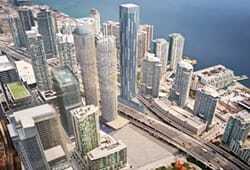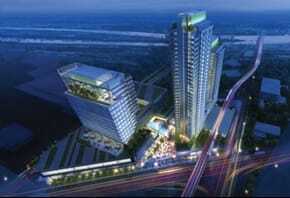With its diverse economy, tightly regulated financial institutions, reasonably valued housing industry, and sound public finances, Canada has a real estate market that is the envy of countries around the globe.
Along with its neighbors to the south, Washington and Oregon, Canada is experiencing strong demand for product while developers remain cautious about overbuilding. The Vancouver real estate market, for instance, is very healthy, and a substantial amount of pension fund and private capital is looking for real estate opportunities, says Gino Nonni, president of Wesgroup Properties, a family-owned real estate company based in the city.
“In Vancouver, we’ve had the benefit of a strong market that, from the residential perspective, has been fueled by buyers from the Far East,” he says. “Asian buyers continue to purchase residential units, and that’s quite positive for us. The other strong part of our business is that the Canadian market has been protected by our own underwriting criteria. We have a solid banking system that requires developers to have a significant amount of equity if they want to borrow money. The Vancouver real estate market is not in a bubble, because the market is not overbuilt commercially or residentially. Stringent lending requirements require developers and the end buyer to provide equity and show that they can afford to buy a home or condo.”
Canada’s lending practices are vastly different from those in the United States, agrees Andréa Callà, an executive with Tridel, Canada’s largest residential high rise builder with 22 condominium buildings from 30 to 50 stories tall under construction in Toronto. “To get a loan for a condominium, you have to have a job, good credit, and a significant downpayment,” Callà says. “Those strict lending policies have helped the real estate industry. And the sound Canadian banking system is the envy of the world.”
| Tridel is constructing Hullmark Centre, a TEN York (at right center of photo) is |
Thanks to continuing historically low interest rates and strong immigration—particularly from China—real estate activity is expected to remain reasonably vigorous this year, says Michael Ferreira, principal at Vancouver-based Urban Analytics Inc. (UAI), a research and advisory firm focusing on urban multifamily residential development. “As for design, increasing competition in the market is putting more pressure on developers to differentiate their product, and design is one of most obvious ways to accomplish this,” he adds. “However, the high cost of land and affordability concerns in markets like Vancouver will make it challenging.”
Canada, Washington state, and Oregon are some of the bright spots in the North American real estate sector. In Seattle, diversity in the job market, investments in public and social infrastructure, an educated workforce, and policy makers focused on the future have allowed the area to fare better than other regions during the global economic downturn, says Jeff Foster, managing principal of Seattle architecture and design firm GGLO. “The past couple of years have made us all more focused, but at the same time reenergized our commitment to the community,” says Foster. “Design firms seem more and more engaged with nonprofits, volunteering time and space even if there aren’t a lot of funds to donate to support their missions.”
In Oregon, trends in real estate development center on smaller infill developments in targeted markets, such as multifamily housing, as well as on long-term industrial and energy projects, such as liquefied natural gas pipelines and related terminal facilities, says Steven Pfeiffer, a lawyer in the Portland office of Perkins Coie LLP. “Large-scale commercial and retail development remains at a standstill,” he notes. “In the coming year, the real estate development industry will likely see more of the same. The focus in Oregon will be on the reuse of existing building stock or the development of vacant infill lands to meet targeted market needs.”
Real estate markets in Canada continue to be very attractive for commercial real estate investment, but investors are cautious and selective because top-line growth will be harder to come by in the current slower economy, says Constantino “Tino” Argimon, vice president, investments, in the real estate division at Toronto-based Manulife Financial.
“We are active, as always, in the purchase of core office and industrial properties in major Canada metro areas,” he says. “But we expect the development business will experience a soft landing. Economic growth and employment are clearly leveling off, and fundamentals will not support the levels of development activity we saw in 2010–11. Exceptions to this might be residential condo development in the Vancouver area, which seems always hot, and some office and industrial development in Alberta, where oil and gas exploration spending has been robust in the last year and will be funded by well-heeled institutional companies and sponsors.”
Argimon adds that residential property, both single family and multifamily, has been exceptionally strong in the past couple of years despite the economic downturn of 2008 to 2009. “This has no doubt been aided and abetted by declining interest rates,” he says. “However, the adage ‘what goes up must come down’ still is true, and Toronto residential is no exception. 2012 will probably be a year in which the business gives back some of the gains taken during the last few years.”
Dwayne Chahil, president of acquisitions, development, and investments at Vancouver-based Point Grey New Ventures, notes that his company has a half dozen projects underway, including a luxury project in Vancouver’s First Shaughnessy neighborhood that is going through the entitlement process. “This sustainable project will reuse many of the materials from the existing structure, as well as incorporate the green principles of energy efficiency, water and energy conservation, smart building envelope, waste diversion and recycling, reuse of some of the existing building material, and the use of green materials inside,” he explains. “We also have two mixed-use developments that are in the early stages that will be aiming to be LEED [Leadership in Energy and Environmental Design] certified, possibly even the first low- to mid-rise development in Vancouver with a Platinum LEED certification.”
| Left: Hillis Clark is working with the Seattle |
Canada is outperforming most industrial nations in just about every economic measure, Chahil says, noting that though growth is slowing, the country’s economy is underpinned by a stable and sound financial position. “The Canadian financial system has been largely shielded from the financial meltdown experienced in the U.S. and Ireland, Iceland, Greece, Spain, and other European countries because our Canadian financial institutes were fiscally prudent throughout 2008 and remain even more conservative after the 2008 financial crash,” he says. “I think Canadians and new immigrants that are buying at this time are primarily end-users, versus speculators or flippers. The banking industry has also introduced changes—increased downpayment requirements for homes and condos, amortization lowered to 30 years versus 35, reduced refinancing limits to 85 percent of a home’s value—that have helped further shield the real estate market from experiencing similar excesses that led to the demise in other global real estate markets.”
Canada’s condominium development market continues to be robust, says Jim Ritchie, senior vice president at Tridel, who notes that an average of 15,000 condo units are sold annually in the Toronto area. “But in 2011, the sales velocity increased significantly,” he says. “The industry sold some 25,000 units. Last year, we brought a condominium community into the marketplace—Alto at Atria—and sold 70 percent in the first tower in a week. 2011 was a spectacular year.”
Ritchie says condo demand has increased in Toronto for a variety of reasons, including the price discrepancy between a condo and a single-family home. “We are an ethnically diverse city with a lot of real growth,” he notes. “Upwards of 80,000 people move into the Greater Toronto area each year. There seems to be an appetite of 40,000 residential units, with the market tipped in favor of high rise because houses are more expensive. In addition, Canada has record-low interest rates, making homeownership more affordable.”
| Right: PCI Group is planning construction of the Marine Gateway in south Vancouver. The project is expected to be the first built and marketed under the city’s recently adopted Cambie Corridor Plan, which seeks to increase densities along a 55-block stretch of the Canada Line rapid transit corridor. Urban Analytics Inc. provided research and analysis that helped the developer secure construction financing. |
Canada is also seeing a number of large projects begin construction. Wesgroup is developing the head office for TransLink, metro Vancouver’s regional transportation authority, and construction has begun on the transit police facility it is developing in the Brewery District in New Westminster, British Columbia’s oldest urban neighborhood, with completion scheduled in 2013.
“We believe our economic growth will be slow and steady, barring any catastrophic global event that would have an impact on our economy,” Nonni notes. “We are well-positioned for the future. Many developers here have gone through two or three cycles of bad times and have learned from that, so they develop in a responsible manner. We believe the future is very, very positive.”
Though 2011 was stronger than many expected in terms of sales, there is a sense that the consumer is increasingly nervous about how global financial events may affect their jobs, says Ferreira of UAI. “2012 will be a year of plateauing in the Canadian real estate market,” he predicts.
UAI is involved in a number of developments in the Vancouver area, including Marine Gateway, a comprehensive planned community in south Vancouver that will have a mix of both market-rate condominiums and rental housing, as well as office, retail, and entertainment space. Also in the works is Fraser Mills, a large master-planned community in Coquitlam, a Vancouver suburb.
Neighboring Washington state is also seeing robust real estate sectors. Because of strong employment from growing companies such as Amazon, Microsoft, Starbucks, and others, Seattle’s multifamily market remains strong, says Foster. “Their employees are seeking housing closer to work in more urbanized areas, and we have seen interest by our clients who want to respond to that demand. Demand for workforce housing—for those earning 80 percent to 120 percent of our area’s median income—will continue to grow.”
GGLO is involved with a number of developments in the area, including AvalonBay Communities’ University District Apartments; Amli Residential’s Ballard Apartments; and South Lake Union Apartments and Yesler Terrace for the Seattle Housing Authority.
The Puget Sound region has many reasons to be optimistic, says T. Ryan Durkan, principal and chair of the land use practice group at Seattle’s Hillis Clark Martin & Peterson P.S. (HCMP). “We predict we will continue to see a resurrection of transactional work as investors pick up perceived bargains in an area some have identified as a ‘wealth island,’ ” she says. “As the transactional work leads the way, we expect the design and development work will follow. A few trends we predict include continued interest in apartments, more interest in transit-oriented development, adaptive reuse of existing structures for new purposes, and reworking of projects placed on hold so they can be resurrected. Design and development professionals will no doubt be needed to respond to each of these trends.”
| AMLI Residential Partners LLC’s proposed seven-story, mixed-use building in Seattle, providing 304 residential units and 12,000 square feet (1,100 sq m) of retail space, was designed by GGLO. |
Still, lenders are cautious, though they are willing to lend on projects that have a proven market demand and acceptable price points, says David E. Myre, Jr., principal and chair of the business real estate practice group at HCMP. “The challenge and opportunity for the real estate and design professionals will be to bring their creativity and expertise to projects in a way that responds to market issues, environmental issues, and the continuing revolution in information technology that is changing how and where we live and work,” he says. “Our region has great talent, so we like how the Northwest is positioned to respond to these challenges.”
The Pacific Northwest region is known for its conservation efforts, so it is no surprise that clean manufacturing associated with sustainability is a growing request, says Mark Ludtka, executive vice president of business development at Seattle-based design and architecture firm Callison. “The other area that brings us a reasonable level of stability is the continued growth of industry leaders like Boeing, Amazon, and Microsoft, and companies that have taken root locally as a service provider or supporting industry to complement their needs.”
In the Puget Sound region, the vacancy rate for office space is shrinking, says Ludtka. “We think this means we will see more planning for future office space, provided we can get more certainty from politicians in Washington, D.C., and the financial institutions, as it will take two to three years for any sizable project to be brought on line,” he says. “Also new data centers are still in demand, with increased consumer desire for high-speed internet and technology applications. Many technology companies have developed their applications on a cloud-based platform and are in the process of pushing this out to the consumer. Health care is also a strong market, as health care providers are looking to increase efficiencies and save costs. In the hospitality industry, there are some strategic development opportunities for new large-room hotels to support the region’s convention and cruise industry.”
And the race is on for urban multifamily projects in Seattle, says Kristine Wilson, a lawyer in the Bellevue office of Perkins Coie. “Whether buying up existing or entitled projects or finding prime sites for new projects, developers, investors, and property managers are looking to capture tenants in up-and-coming downtown neighborhoods,” she says. “Our experience has also shown that the market for high-quality existing projects with creditworthy tenants is very strong with institutional investors. In the coming year, we also predict that Seattle will see greater focus on the changing landscapes of the downtown waterfront and Mercer Street corridor as transportation projects in those areas see visible progress.”
Perkins Coie is representing buyers, investors, and lenders in the acquisition or development of several Seattle multifamily projects. “We are working on public/private partnership deals involving mixed-use, retail, and multifamily residential developments,” says Wilson. “We also continue to represent corporations in expansion of space or renegotiation of office leases in Seattle, Bellevue, Portland, and surrounding markets.” Among the projects in which the Portland office of Perkins Coie has recently been involved is Vestas-American Wind Technology, a manufacturer of wind turbines, which is seeking to lease over 133,000 square feet (12,400 sq m) of office space for its new North American headquarters.
| In 2011, Legacy Partners Residential sold the three-year-old, 248-unit Legacy at Pratt Park multifamily and retail development on South Jackson Street in Seattle to Cornerstone Real Estate Advisers of Hartford, Connecticut. The site was once occupied by Wonder Bread. Perkins Coie represented Cornerstone Real Estate Advisers in the transaction. |
The Oregon area will continue to see activity in the multifamily/rental market because the private sector is more bullish on financing in that sector, points out Bob Packard, managing partner at Portland-based ZGF Architects LLP.
“Multifamily continues to be in demand,” he says. “Clean tech is another newer tenant type emerging. Corporate clients such as Microsoft and Amazon are building larger data centers. Those regional companies who are global players are expanding. Developers are continuing to buy older properties and retrofitting/greening for Class B office space and startup companies.”
ZGF Architects is working with the developers of Seattle’s North Lot development adjacent to two professional sports stadiums, which provide a lively location for a sustainable, mixed-use, transit-oriented development. “North Lot development includes Stadium Place, which features 700 mixed-income residential units—market rate and workforce—above retail and the parking podium,” says Packard. “Additionally, Stadium Towers features 420,000 square feet [40,000 sq m] of office and hotel.”
Thanks to cautious lending practices, well-thought-out projects, and fears of overbuilding, the real estate markets in Canada and the Pacific Northwest are expected to remain stable in the year ahead.







